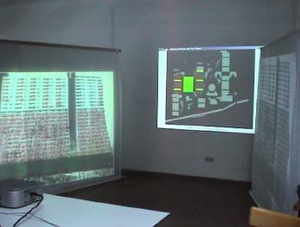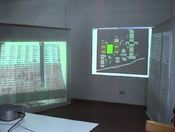Information
- Publication Type: Journal Paper (without talk)
- Workgroup(s)/Project(s): not specified
- Date: July 2004
- ISSN: 1617-4909
- Journal: Personal and Ubiquitous Computing
- Number: 5
- Volume: 8
- Pages: 310 – 325
Abstract
In many environments, the landscape of space and artefacts is evolving and changing with the tasks at hand. Integrating digital media and computation in these environments has to take into account the fact that people will configure space functions and tools according to the situation, organising use in unexpected ways. In this article, we present and discuss how the issue of configurability is dealt with, in a series of field trials with design students. The aim of these trials was to construct, for architecture and interaction design students, a mixed-media environment for inspirational learning. The results include physical infrastructure in space and in furniture as integral parts of the interaction technology and the creation of composite representations called ldquomixed objectslsquorsquo, which blend digital and non-digital media in one design artefact. Configurability has to be supported at different levels (infrastructures, artefacts, functions) and across the physical and digital realms.Additional Files and Images
Weblinks
No further information available.BibTeX
@article{binder-2004-supp,
title = "Supporting Configurability in a Tangibly Augmented
Environment for Design Students",
author = "Thomas Binder and Georgio De Michelis and Michael Gervautz
and Giulio Iacucci and Kresimir Matkovic and Thomas Psik and
Ina Wagner",
year = "2004",
abstract = "In many environments, the landscape of space and artefacts
is evolving and changing with the tasks at hand. Integrating
digital media and computation in these environments has to
take into account the fact that people will configure space
functions and tools according to the situation, organising
use in unexpected ways. In this article, we present and
discuss how the issue of configurability is dealt with, in a
series of field trials with design students. The aim of
these trials was to construct, for architecture and
interaction design students, a mixed-media environment for
inspirational learning. The results include physical
infrastructure in space and in furniture as integral parts
of the interaction technology and the creation of composite
representations called ldquomixed objectslsquorsquo, which
blend digital and non-digital media in one design artefact.
Configurability has to be supported at different levels
(infrastructures, artefacts, functions) and across the
physical and digital realms.",
month = jul,
issn = "1617-4909",
journal = "Personal and Ubiquitous Computing",
number = "5",
volume = "8",
pages = "310--325",
URL = "https://www.cg.tuwien.ac.at/research/publications/2004/binder-2004-supp/",
}


 pdf
pdf
